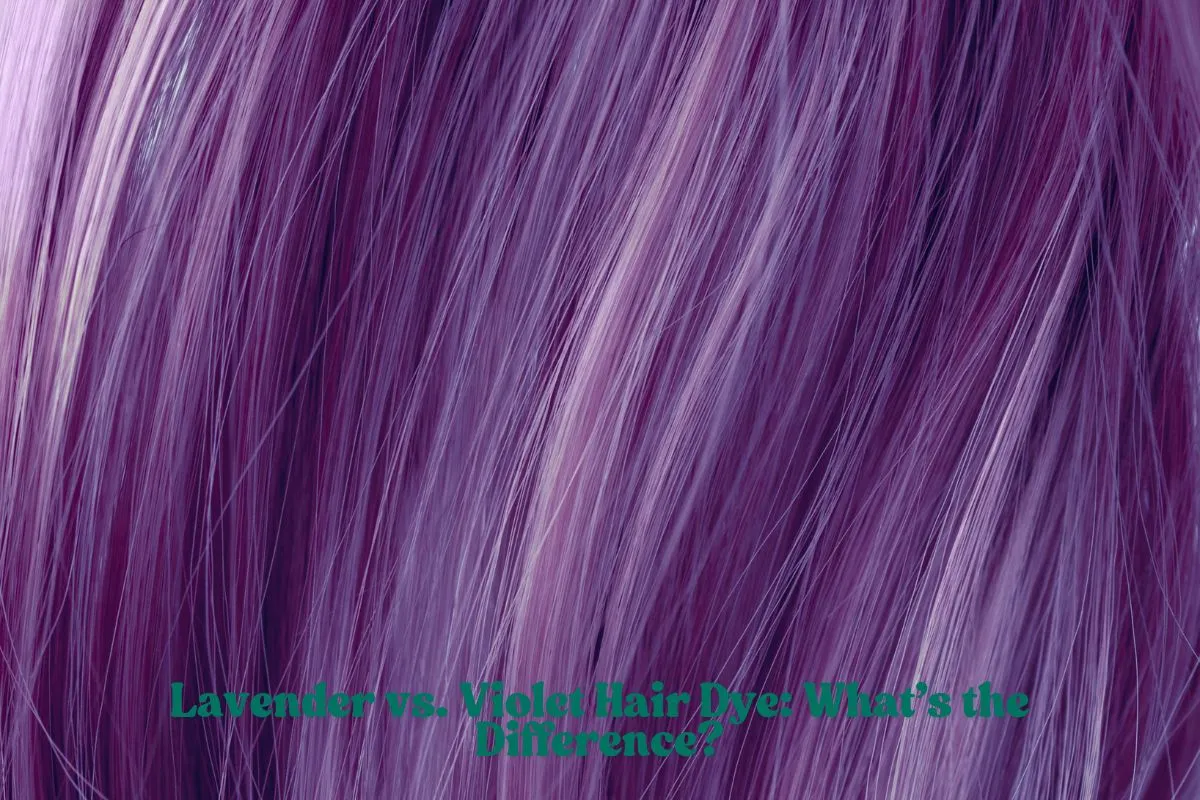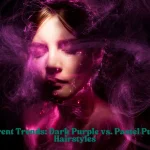Whether you’re looking to make a bold hair color choice or explore the dreamy world of fashion hair colors, purple tones are some of the most versatile and eye-catching options out there. But when it comes to choosing between lavender vs. violet hair dye, the difference goes beyond just shade—it’s about skin tone compatibility, color longevity, hair dye formulas, and the overall aesthetic you want to achieve.
In this guide, we’ll break down everything you need to know about these two stunning shades—from hair color undertones and fade rates to which skin tones they flatter best.
Lavender vs. Violet Hair Dye: Quick Overview
At first glance, lavender and violet might seem like two sides of the same purple coin. While they are both members of the purple family, they represent different hues, pigment depths, and undertones.
-
Lavender hair dye is a soft purple hue with more cool-toned purple undertones, often appearing light, airy, and romantic. It sits closer to pastels and is generally more muted.
-
Violet hair dye is a rich jewel tone with deeper pigmentation, often having both cool and warm elements depending on the brand. It’s darker, bolder, and packs more drama.
Let’s dive into the details that truly differentiate these two gorgeous colors.
Lavender Hair Dye: The Pastel Darling
What Is Lavender Hair Dye?
Lavender hair dye is a muted pastel color, often mixed with silvery or ashy undertones. It’s a favorite for people who love soft, feminine hues or want to experiment with pastel purple hair dyes without going too dark or vibrant.
Best Hair Base for Lavender Dye
Lavender works best on pre-lightened or platinum hair. Lavender hair dye for light hair is more effective because the lighter base allows the pastel pigments to shine through. If your hair is too dark, the color may not show up well without bleaching.
Ideal for Cool-Toned Skin
If you have pink or neutral undertones, lavender hair dye for cool skin tones will complement your complexion beautifully. It enhances the rosiness in your cheeks and gives a soft, dreamy finish.
Popular Variations
-
Lavender vs. Lilac Hair Color: Lilac tends to be slightly warmer and more saturated, whereas lavender is cooler and lighter.
-
Semi-permanent lavender dye is widely used for short-term makeovers and is gentle on the hair.
Violet Hair Dye: Bold and Beautiful
What Is Violet Hair Dye?
Violet hair dye features vibrant purple pigments and a higher hair color depth than lavender. It’s richer and bolder, making it a go-to for those looking for a more vivid purple that still feels elegant.
Works on Darker Hair
Unlike lavender, violet hair dye on dark hair can show up fairly well, especially if it’s a deep violet hair dye or a formula with intense pigments. While pre-lightening still helps for optimal vibrancy, brunettes can achieve noticeable results without heavy bleaching.
Warm or Cool – You Choose
Some violet dyes lean cooler (with blue undertones), while others are warmer (with red undertones). When choosing between cool-toned vs. warm-toned hair dyes, look at your skin’s undertone and the color swatches provided by the brand. This ensures the tone harmonizes with your natural coloring.
Popular Variations
-
Violet vs. Plum Hair Dye: Plum is more reddish or burgundy-toned, while violet sticks closer to true purple.
Key Differences Between Lavender and Violet Hair Dye
| Feature | Lavender Hair Dye | Violet Hair Dye |
|---|---|---|
| Tone | Cool-toned, pastel | Deep, rich jewel tone |
| Best for Skin Tone | Cool skin tones | Neutral or warm tones |
| Base Color Needed | Light blonde/platinum | Medium to dark hair |
| Vibe | Soft, whimsical | Bold and dramatic |
| Fade Rate | Fades faster | Fades slower |
Hair Dye Color Chart: Understanding Undertones
Before buying a hair dye, consult the hair dye color chart (purple section) to determine the hair color undertone—whether it leans toward blue, red, or silver. This is especially important when comparing shades like lavender, lilac, violet, and plum.
Lavender typically sits in the cool-toned purple category, while violet can go either way depending on formulation. Matching the undertone to your skin tone gives a more harmonious and flattering result.
Fading Process of Purple Hair Dye
The fading process of purple hair dye varies significantly between lavender and violet:
-
Lavender being pastel, tends to fade quickly—sometimes in as little as 5–8 washes depending on the brand and hair porosity.
-
Violet has a stronger pigment load and often offers long-lasting hair color, especially if you’re using sulfate-free shampoos and cold water rinses.
Factors That Affect Hair Dye Fade Rate
-
Hair porosity and damage
-
Type of shampoo and water temperature
-
UV exposure and heat styling
-
Use of color-protecting conditioners
️ How to Choose a Purple Hair Dye
Choosing the right purple hair dye depends on a few key factors:
-
Your Hair’s Current Color – If your hair is dark and you don’t want to bleach, go with a violet hair dye on dark hair or try a pigmented conditioner.
-
Desired Intensity – For soft and dreamy, pick lavender. For bold hair color choice, go violet.
-
Skin Tone Compatibility – Use the undertone guide to match your skin’s warmth or coolness.
-
Commitment Level – A semi-permanent lavender dye offers a temporary style change, while a permanent violet dye will last longer but requires more upkeep.
Bonus Tips for Purple Hair Success
-
Always pre-lighten your hair (especially for pastels like lavender) to get true color results.
-
Consider strand testing a small section before full application.
-
Invest in a purple or color-depositing shampoo to maintain vibrancy between color sessions.
-
Protect your hair from sun exposure, chlorine, and heat to preserve your fashion hair colors.
✨ Final Thoughts
Both lavender and violet hair dyes bring something unique to the table. Whether you’re drawn to the soft purple hue of lavender or the rich jewel tone of violet, understanding the fading process, undertones, and color depth can help you make the best decision for your next hair adventure.
Lavender is best for those who love ethereal, delicate vibes and already have light hair, while violet offers a stronger punch of color and works better for a broader range of base shades. Whichever you choose, embrace the beauty of purple and let your hair do the talking.




